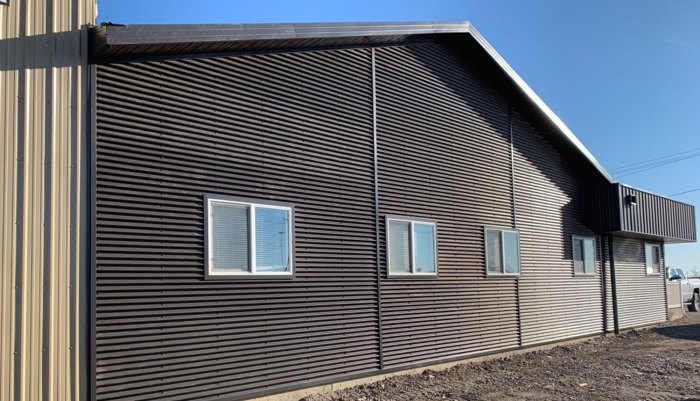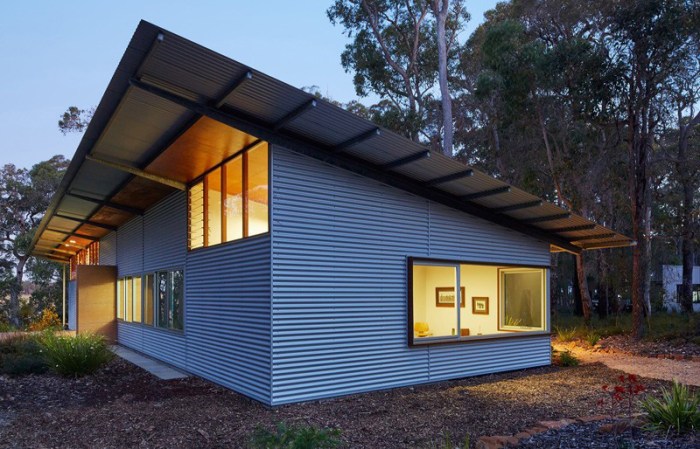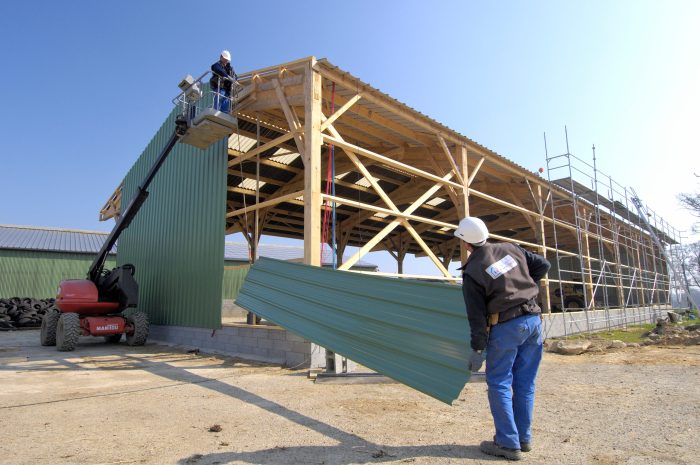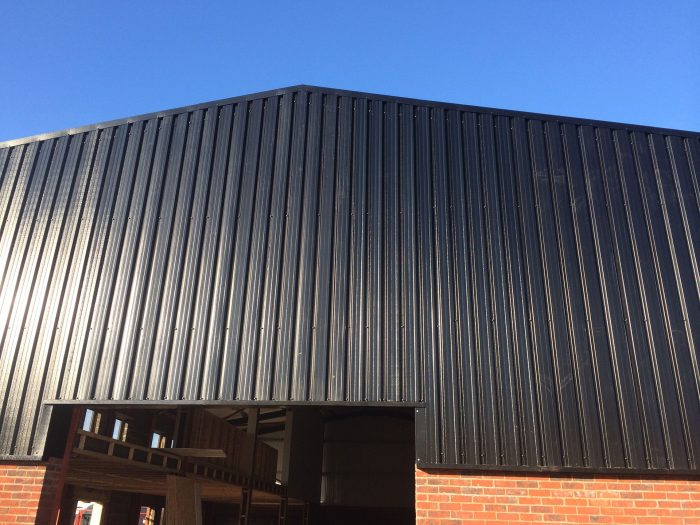Commercial Corrugated Metal Siding A Complete Guide

Commercial corrugated metal siding offers a durable and aesthetically versatile solution for commercial building exteriors. From its robust material properties and diverse installation methods to its design flexibility and cost-effectiveness, understanding its nuances is key to successful implementation. This guide explores every aspect, from choosing the right metal and coating to budgeting and maintenance, ensuring you’re well-equipped to make informed decisions.
We’ll delve into the specifics of different metal types—steel, aluminum, zinc—and their respective gauge thicknesses, impacting both durability and budget. We’ll also examine protective coatings like Galvalume and Kynar, explaining their roles in longevity and corrosion resistance. The installation process, including fastening techniques, sealing methods, and tackling common challenges like curves and corners, will be covered in detail. Finally, we’ll explore design applications, cost analysis, and long-term maintenance strategies to ensure your commercial building’s siding remains both beautiful and functional for years to come.
Material Properties of Commercial Corrugated Metal Siding
Choosing the right metal siding for your commercial building is a crucial decision impacting longevity, aesthetics, and budget. Understanding the properties of different metals and their coatings is key to making an informed choice. This section details the material properties to consider when selecting commercial corrugated metal siding.
Metal Types Used in Commercial Corrugated Siding
Commercial corrugated metal siding is typically made from steel, aluminum, or zinc, each offering unique advantages and disadvantages. Steel is the most common due to its strength and cost-effectiveness. Aluminum offers superior corrosion resistance but is generally more expensive. Zinc, often used as a coating (Galvanized steel), provides excellent corrosion protection, particularly in harsh environments. The choice depends on the specific project requirements and budget constraints. For example, a coastal building might benefit from the superior corrosion resistance of aluminum or zinc-coated steel.
Gauge Thickness and its Impact
The gauge of the metal refers to its thickness. Thicker gauges (lower numbers, e.g., 24 gauge) are more durable and resistant to dents and damage but are also more expensive. Thinner gauges (higher numbers, e.g., 29 gauge) are lighter, easier to handle, and less costly, but they are more susceptible to damage. The optimal gauge depends on the expected environmental conditions and the building’s location. A building in a high-wind area might require a thicker gauge for increased structural integrity.
The Role of Coatings in Corrosion and Weathering Protection
Coatings significantly extend the lifespan and enhance the appearance of metal siding. Galvalume, a zinc-aluminum alloy coating, offers superior corrosion resistance compared to galvanized steel (zinc coating). Kynar, a polyvinylidene fluoride (PVDF) coating, provides excellent color retention and resistance to fading, chalking, and weathering. These coatings create a protective barrier against the elements, preventing rust and extending the life of the siding. Buildings in areas with high humidity or significant UV exposure greatly benefit from these advanced coatings.
Lifespan and Maintenance Requirements
The lifespan and maintenance requirements of metal siding vary significantly depending on the metal type and coating. Steel with a Galvalume coating can last for several decades with minimal maintenance, requiring only occasional cleaning. Aluminum siding, due to its inherent corrosion resistance, boasts even longer lifespans with similarly low maintenance. Proper maintenance, including regular cleaning and prompt repair of any damage, is essential to maximizing the lifespan of any metal siding. Neglecting maintenance can lead to premature corrosion and reduced lifespan.
Installation Methods and Techniques for Commercial Corrugated Metal Siding

Source: formasteel.ca
Installing commercial corrugated metal siding requires careful planning and execution to ensure a durable, weathertight, and aesthetically pleasing finish. This process involves several key steps, from preparation to final finishing, and requires the use of specialized tools and techniques. Proper installation significantly impacts the longevity and performance of the siding.
Step-by-Step Installation Guide
The installation process typically begins with preparing the substrate. This involves ensuring a clean, level, and structurally sound surface. Any existing damage needs repair, and appropriate underlayment might be required depending on the building’s condition and climate. Next, the framing is established, providing a solid base for the siding panels. Accurate measurements and precise cuts are crucial for a seamless finish. Panels are then installed, overlapping appropriately, and secured using fasteners. Finally, sealant is applied to ensure watertightness at all joints and edges.
Fastening and Sealing Methods
Securing the panels correctly is paramount for preventing leaks and maintaining the structural integrity of the siding. Fasteners should be chosen based on the material of the siding and the building’s exposure to the elements. Self-drilling screws are commonly used, but rivets may be preferred in high-wind areas or for applications requiring enhanced strength. The screws should be installed at the appropriate spacing and depth to avoid damaging the panel or creating stress points. Sealants, such as silicone caulk or butyl tape, are applied to all joints and seams to prevent water penetration. This step is crucial for ensuring a long-lasting, watertight installation.
Tools and Equipment
Installing corrugated metal siding requires specific tools for efficient and accurate installation. These include measuring tapes, levels, tin snips or shears, drills with appropriate bits, rivet guns (if using rivets), sealant applicators, and safety equipment such as gloves and safety glasses. A power drill significantly speeds up the fastening process, and a pneumatic rivet gun increases efficiency when using rivets. The use of appropriate safety gear is crucial to minimize the risk of injuries.
Addressing Installation Challenges
Working with curves, corners, and varying roof pitches presents unique challenges. For curves, specialized panel bending techniques or pre-bent panels might be necessary. Corners require careful planning and precise cuts to ensure a clean, watertight fit. Different roof pitches may necessitate adjustments in panel installation and fastening techniques to accommodate the varying angles. Careful planning and the use of appropriate tools and techniques are essential to overcome these challenges. Pre-fabrication of complex sections can significantly reduce on-site challenges.
Comparison of Fastening Methods
| Method | Advantages | Disadvantages | Cost |
|---|---|---|---|
| Screws | Easy to install, readily available, relatively inexpensive | Can loosen over time, require careful placement to avoid damage | Low |
| Rivets | Strong, permanent bond, resistant to loosening | More complex installation, requires specialized tools, a higher initial cost. | Medium |
| Welding | Extremely strong and durable, permanent | Requires specialized equipment and expertise, more expensive | High |
| Bonding Adhesives | Clean installation, suitable for certain applications | Requires careful surface preparation, may not be suitable for all climates or conditions, longer curing time | Medium-High |
Design Considerations for Commercial Corrugated Metal Siding
Choosing the right corrugated metal siding for your commercial building is crucial, impacting both aesthetics and functionality. The material offers a surprising level of design flexibility, allowing for creative expression while maintaining durability and efficiency. This section explores the design aspects you should consider when specifying corrugated metal siding for your project.
Color and Profile Options
The variety in color and profile options for corrugated metal siding is extensive. Imagine a sleek, modern office building clad in deep charcoal grey, its subtle texture emphasized by a narrow, tightly-crimped profile. Contrast this with a rustic farmhouse-style restaurant featuring warm, earthy tones like burnt orange or deep red, accentuated by a wider, more pronounced corrugated profile. For an industrial-chic warehouse, a galvanized steel finish with a classic, widely spaced corrugated pattern might be the perfect choice. These variations, along with numerous other color and profile combinations, allow for a vast range of architectural styles and expressions. The possibilities extend beyond standard colors too, with options for custom colors and finishes, allowing for truly unique building designs.
Aesthetic Impact on Commercial Buildings
Corrugated metal siding’s impact on a building’s aesthetic is profound. The choice of color directly influences the overall mood and feel. Lighter colors reflect more light, creating a brighter, more open appearance, while darker colors can create a more dramatic, sophisticated look. The profile of the siding also plays a significant role. A tightly crimped profile gives a cleaner, more modern feel, while a wider corrugation can lend a more rustic or industrial character. The combination of color, profile, and the overall building design creates a unique visual identity. For example, a vibrant blue corrugated metal siding on a contemporary retail space projects a sense of energy and modernity, whereas a muted green on a rural farm store evokes a feeling of tranquility and connection to nature.
Energy Efficiency Considerations
Corrugated metal siding can significantly contribute to a building’s energy efficiency. Its high reflectivity, particularly with lighter colors, helps to reduce heat absorption, lowering cooling costs. This is especially beneficial in warmer climates. While metal itself conducts heat, the air gap created by the corrugations and the addition of insulation behind the siding effectively mitigates this. The reflective properties can reduce the urban heat island effect, contributing to a more sustainable building design. For instance, a building with light-colored corrugated metal siding might experience a 10-15% reduction in cooling costs compared to a similar building with dark-colored siding. Furthermore, incorporating insulation further enhances the energy-saving benefits.
Visual Representations of Corrugated Metal Siding on Different Building Styles
Imagine four distinct images:
Image 1: Modern Office Building. A tall, glass-fronted building with clean lines, clad in a light grey, tightly-crimped corrugated metal siding. The siding’s subtle texture complements the building’s modern aesthetic, while the light color reflects sunlight, minimizing heat gain.
Image 2: Rustic Farmhouse Restaurant. A low-slung building with exposed wooden beams, featuring warm, reddish-brown corrugated metal siding with a wider, more pronounced corrugation. The siding’s rustic character harmonizes with the building’s traditional style.
Image 3: Industrial Warehouse. A large, boxy structure with large windows and high ceilings, clad in galvanized steel corrugated metal siding with a classic, widely spaced corrugation. The raw, unpainted metal adds to the building’s industrial charm.
Image 4: Contemporary Retail Space. A sleek, single-story building with a flat roof, showcasing vibrant blue corrugated metal siding with a subtle, almost imperceptible texture. The bright color creates a lively and welcoming atmosphere. The design utilizes strategically placed windows to maximize natural light.
Cost Analysis and Budgetary Considerations for Commercial Corrugated Metal Siding

Source: contemporist.com
Choosing the right siding for your commercial building involves careful consideration of many factors, and cost is a major one. This section breaks down the costs associated with commercial corrugated metal siding, allowing you to make informed decisions during the budgeting phase of your project. We’ll compare it to other options and show you how to build a realistic budget.
Cost Breakdown of Corrugated Metal Siding
The total cost of installing corrugated metal siding on a commercial building is comprised of several key elements: material costs, labor costs, and the costs associated with installation. Material costs vary based on the type of metal (steel, aluminum, zinc), gauge (thickness), finish (color, coating), and any additional features like insulation. Labor costs depend on the complexity of the project, the size of the building, and the local prevailing wage rates. Installation costs encompass everything from site preparation to the final finishing touches. Remember to factor in permits and inspections as well; these costs vary significantly by location. A detailed breakdown is crucial for accurate budgeting.
Comparison with Other Cladding Options, Commercial corrugated metal siding
Corrugated metal siding often offers a compelling value proposition when compared to other commercial cladding materials. While initial costs might seem higher than vinyl siding, for instance, metal siding boasts significantly longer lifespan, requiring less maintenance and replacement over the long term. Brick, on the other hand, presents a higher upfront cost and more complex installation process. A life-cycle cost analysis—considering initial cost, maintenance, and lifespan—is crucial for a fair comparison. For example, a building with metal siding might require repainting less frequently than one with wood siding, resulting in long-term savings.
Factors Influencing Overall Cost
Several factors significantly impact the final cost of your corrugated metal siding project. The size and complexity of the building are major contributors; a large, multi-story building will naturally require more materials and labor than a smaller, simpler structure. The chosen material itself influences cost; thicker gauge metal is more durable but also more expensive. The chosen finish, such as a specialized coating for corrosion resistance, also adds to the cost. Finally, geographic location affects both material and labor costs; labor rates vary considerably across different regions.
Creating a Budget for Corrugated Metal Siding
Developing a comprehensive budget is essential for successful project management. Start by accurately estimating the building’s surface area requiring siding. Then, obtain quotes from multiple suppliers for materials, considering various options to compare pricing and features. Next, secure bids from several reputable contractors for installation, comparing their experience, insurance coverage, and proposed timelines. Remember to allocate funds for permits, inspections, and any unforeseen expenses (a contingency of 5-10% is generally recommended).
Sample Budget Table
| Item | Quantity | Unit Cost | Total Cost |
|---|---|---|---|
| Corrugated Metal Panels | 1000 sq ft | $5/sq ft | $5000 |
| Fasteners and Sealants | 1000 units | $1/unit | $1000 |
| Labor (Installation) | 100 hours | $50/hour | $5000 |
| Permits and Inspections | 1 set | $500 | $500 |
| Contingency (10%) | – | – | $1150 |
| Total Estimated Cost | – | – | $13150 |
Maintenance and Repair of Commercial Corrugated Metal Siding

Source: rpsmetalroofing.com
Commercial corrugated metal siding, while incredibly durable, requires regular maintenance to ensure longevity and prevent costly repairs down the line. Neglecting maintenance can lead to premature deterioration and significantly reduce the lifespan of your building’s exterior. This section details common problems, cleaning and maintenance procedures, repair techniques, and the importance of regular inspections.
Common Problems Associated with Commercial Corrugated Metal Siding
Several issues can affect commercial corrugated metal siding over time. These include dents and scratches from impacts, corrosion due to exposure to the elements, and fading from prolonged sun exposure. Dents can compromise the structural integrity of the panels, while corrosion weakens the metal, leading to potential leaks and further damage. Fading, although primarily cosmetic, can detract from the building’s overall appearance. Regular inspections can help identify these issues early, allowing for timely intervention and preventing escalation.
Cleaning and Maintaining Corrugated Metal Siding
Maintaining clean siding is crucial for preventing corrosion and extending its lifespan. A regular cleaning schedule, ideally twice a year (spring and fall), is recommended. Begin by rinsing the siding with a pressure washer set to a low pressure to avoid damaging the panels. For stubborn dirt or grime, use a mild detergent solution and a soft-bristled brush. Always rinse thoroughly afterward to remove all traces of soap. Avoid harsh chemicals or abrasive cleaners, as these can scratch the surface and accelerate corrosion. For higher buildings, professional cleaning services equipped with appropriate safety measures are recommended.
Repairing Minor Damage to Commercial Corrugated Metal Siding
Minor dents can often be repaired using a specialized dent puller or by carefully filling the dent with a metal filler designed for exterior applications. Ensure proper preparation and application according to the manufacturer’s instructions. For more significant damage, such as large dents or corrosion, replacing the affected panel is usually necessary. This involves carefully removing the damaged panel, ensuring proper measurements, and installing a new panel, securing it with appropriate fasteners. Always ensure that the replacement panel matches the existing siding in color and gauge. For extensive repairs or replacements, it is best to consult with a professional contractor experienced in working with commercial corrugated metal siding.
Importance of Regular Inspections and Preventative Maintenance
Regular inspections are vital for early detection of potential problems. Ideally, conduct inspections at least twice a year, focusing on areas prone to damage, such as corners, edges, and low-lying areas. Look for signs of corrosion, dents, scratches, loose fasteners, or sealant failure. Addressing minor issues promptly can prevent them from escalating into costly repairs. A preventative maintenance program, including regular cleaning and inspections, can significantly extend the lifespan of your commercial corrugated metal siding and maintain the building’s aesthetic appeal. Proactive maintenance is significantly cheaper than reactive repairs. For example, replacing a single damaged panel costs considerably less than replacing an entire wall section due to neglected corrosion.
Last Recap

Source: roofingsheetsbyrhino.com
Choosing commercial corrugated metal siding involves careful consideration of material properties, installation techniques, design aesthetics, and budgetary constraints. By understanding the various factors involved—from metal type and coating selection to long-term maintenance—you can ensure a durable, attractive, and cost-effective solution for your commercial building. This guide has provided a comprehensive overview, empowering you to make informed decisions that will benefit your project for years to come. Remember to consult with professionals for specific project needs and local building codes.
Popular Questions
What are the typical lifespan expectations for different types of commercial corrugated metal siding?
Lifespan varies greatly depending on the metal type, coating, and environmental conditions. Steel with a high-quality coating can last 50+ years, while aluminum might last slightly less. Zinc is known for its corrosion resistance but might be more expensive.
How much does professional installation typically cost?
Installation costs depend on factors like building size, complexity, location, and labor rates. It’s best to get multiple quotes from reputable contractors.
Can I install corrugated metal siding myself?
While DIY is possible for smaller projects, professional installation is generally recommended for larger commercial buildings to ensure proper water tightness and longevity. Improper installation can lead to costly repairs down the line.
What are some common signs that my corrugated metal siding needs repair?
Look for dents, scratches, rust, peeling paint, or any signs of water damage. Regular inspections are crucial for early problem detection.
Are there any environmental considerations when choosing corrugated metal siding?
Recycled metal options are available, minimizing environmental impact. The reflectivity of certain colors can also contribute to energy efficiency, reducing cooling costs.
Comments are closed.